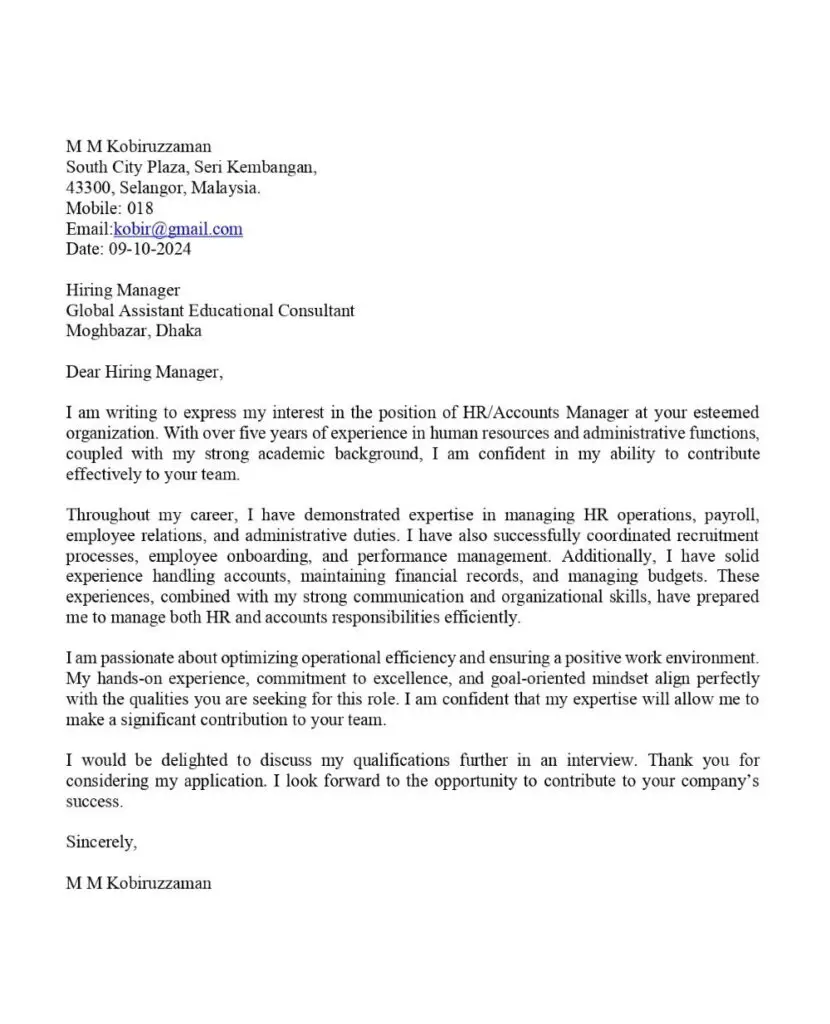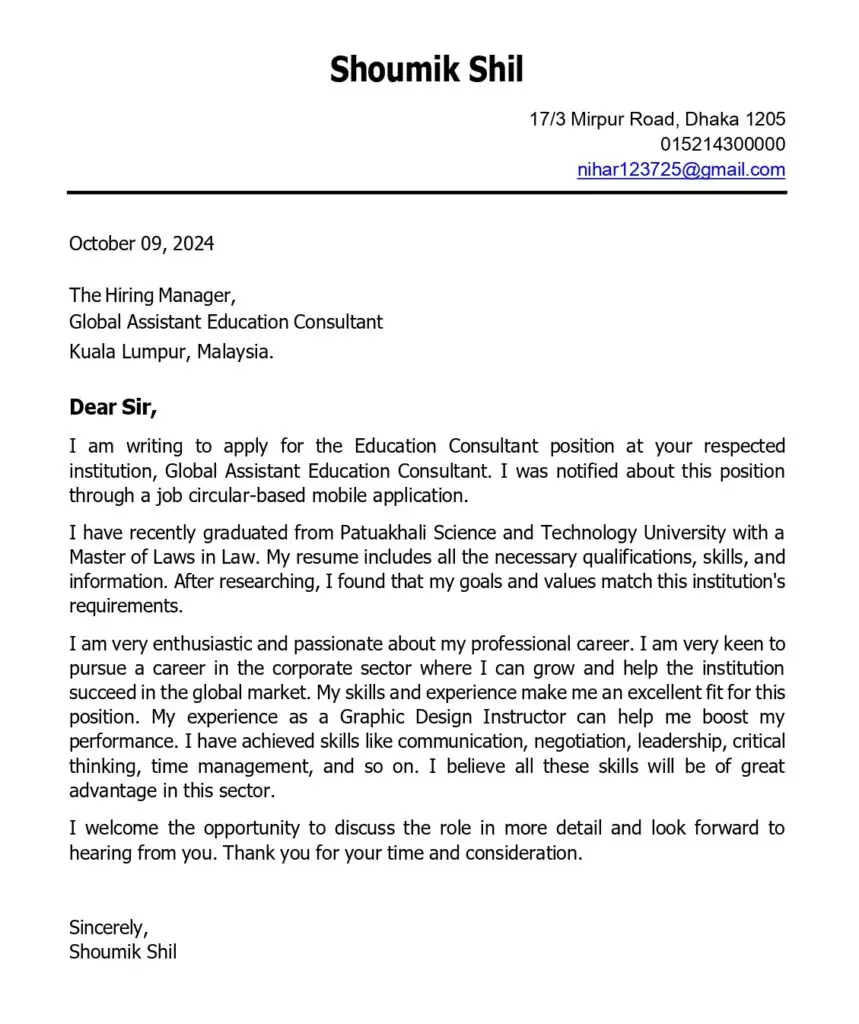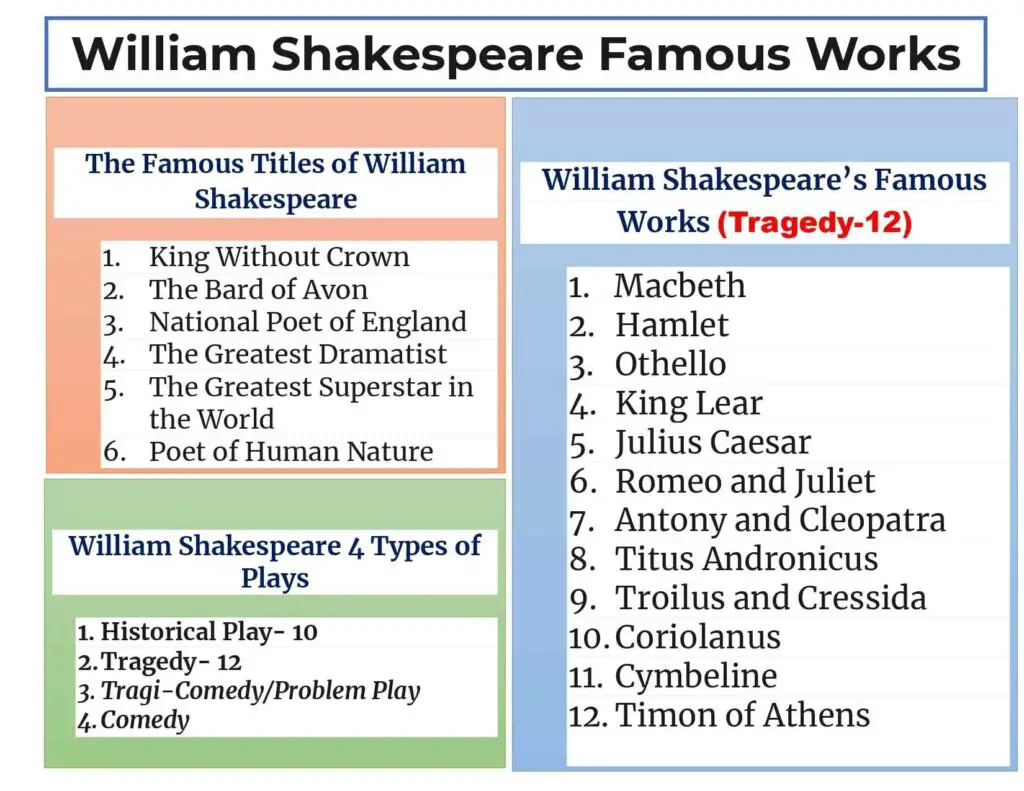This Article Explains How to Make a Sample Email Cover Letter With an Attached Resume.
Email Cover Letter
The email cover letter is the body of the email that explains the applicant’s potential, along with the attached resume. It is a crucial part of the job application to attract and convince interviewers. A well-crafted, attractive email cover letter increases the chances of being invited to a job interview. Apart from the job application, an email cover letter is crucial for confirming admission, along with a statement of purpose.
Today, we will demonstrate some samples of email cover letters to assist applicants. These email cover letter examples help job seekers write their job application emails with CVs. The authors wrote a few examples of email cover letters followed by the instructions. However, we have collected some examples from candidates who wrote those email cover letters for job applications. Additionally, we have adopted an email cover letter example from ChatGPT. You might visit the following article to learn how to introduce yourself in a job interview session: “Self-introduction Sample For Job Interview.”
Job Application Email Vs Email Cover Letter
The job application email is the body of the email that explains the applicant’s potential, including skills, education, and experience. In contrast, an email cover letter for a job application refers to an application letter attached to a CV. It is a separate letter that explains in detail the applicant’s potential to attract employers.
Sample Email Cover Letter In Word, Adopted From ChatGPT
Subject: Application for [Position Title] – [Your Name]
Dear Hiring Manager,
I am writing to express my interest in the [Position Title] position at [Company Name], as advertised on [where you found the job posting]. With a strong background in [relevant field or industry] and [number of years] years of experience, I am confident I can contribute effectively to your team.
I have attached my video resume for your review, which outlines my educational background, professional experience, and key skills. [Briefly mention any specific qualifications or achievements that make you a strong candidate for the position.]
Throughout my career, I have demonstrated a track record of [mention specific accomplishments or experiences relevant to the job]. I am particularly excited about the opportunity to [mention a particular aspect of the job or company that interests you] and believe that my [mention relevant skills or experiences] would make me a valuable asset to your team.
I am highly motivated, detail-oriented, and passionate about [mention relevant industry or field]. Additionally, I thrive in fast-paced environments and enjoy collaborating with colleagues to achieve common goals.
I am eager to discuss in more detail how my background, skills, and enthusiasm align with your team’s needs. I am available for an interview at your earliest convenience and can be reached at [your phone number] or via email at [your email address]. Thank you for considering my application.
I look forward to the opportunity to contribute to [Company Name] and help drive its continued success.
Sincerely,
[Your Name] [Your Contact Information]
Job Application Email Sample
Email Cover Letter
Subject: Application for Admissions Officer Position — Ahmed Viam Waseem
Dear Hiring Manager,
I am writing to apply for the Admissions Officer position at Global Assistant Education Consultant. With a strong academic background, proven leadership experience, and passion for supporting students in their educational journey, I am confident in my ability to contribute effectively to your team.
I am currently pursuing a Bachelor’s in Strategic Communication at Multimedia University (MMU) Malaysia. My academic journey has been marked by excellence — including ranking 2nd in the national top ten for GCE and IGCSE, and 6th place nationally in A-Levels.
This achievement reflects my dedication, discipline, and strong work ethic.
Previously, I worked as a Senior Administrative Officer and Data Officer, developing key skills in documentation management, communication, task coordination, and record-keeping. I also served as a Data Entry Officer of Revive NGO, where I contributed to a Maldivian historical archiving project – building a structured digital database of historic Maldivian books. These experiences sharpened my interpersonal skills, organizational abilities, and capacity to guide individuals in making informed decisions — qualities essential for this role.
I am proficient in Microsoft Office, including Excel, and possess strong communication and multitasking abilities. With a positive attitude, a willingness to learn, and a genuine commitment to helping students achieve their educational goals, I am excited about the opportunity to join your organization.
Thank you for considering my application. I have attached my CV for your review and would be grateful for the opportunity to discuss how I can contribute to your team.
Kind regards,
Ahmed Viam Waseem
ahmed.viam@gmail.com
HT-23A-15, Garden Plaza, Persiaran Harmoni, Cyberjaya, 63000, Selangor.

Job Email Cover Letter Example 1-17
Sample Email Cover Letter With Attached Resume-1
M M Kobiruzzaman
South City Plaza, Seri Kembangan, 43300, Selangor, Malaysia.
Mobile: 018
Email:kobiruzzam@gmail.com
Date: 09-10-2024
Hiring Manager
Global Assistant Educational Consultant
Kuala Lumpur, Malaysia.
Dear Hiring Manager,
I am writing to express my interest in the HR/Accounts Manager position at your esteemed organization. With over 5 years of experience in human resources and administrative functions, coupled with my strong academic background, I am confident I can contribute effectively to your team.
Throughout my career, I have demonstrated expertise in managing HR operations, payroll, employee relations, and administrative duties. I have also successfully coordinated recruitment processes, employee onboarding, and performance management. Additionally, I have solid experience handling accounts, maintaining financial records, and managing budgets. These experiences, combined with my strong communication and organizational skills, have prepared me to manage both HR and accounts responsibilities efficiently.
I am passionate about optimizing operational efficiency and ensuring a positive work environment. My hands-on experience, commitment to excellence, and goal-oriented mindset align perfectly with the qualities you are seeking for this role. I am confident that my expertise will allow me to make a significant contribution to your team.
I would be delighted to discuss my qualifications further in an interview. Thank you for considering my application. I look forward to the opportunity to contribute to your company’s success.
Sincerely,
M M Kobiruzzaman

Sample Email Cover Letter With Attached CV-2
Good Day,
I am writing to express my interest in the Content Writer position. As a recent graduate with a degree in computer science & engineering, I am enthusiastic about starting my career in content writing. In addition, I am excited about the opportunity to join your team.
I gained practical experience creating engaging and informative content for Roar Bangladesh Ltd. I have also developed strong research skills and a keen eye for detail, essential for creating high-quality content. Your company’s priority on writing particularly tempts me, and my passion would make me a tangible asset to your team.
My skills and enthusiasm for content writing make me a beneficial addition to your team. Thank you for considering my application. I have attached my CV and am awaiting your response.
Sincerely,
Email Cover Letter For IELTS Instructor Job Application-3
Dear Sir,
I am writing to express my keen interest in both the “Spoken and IELTS Instructor” positions at Global Assistant. As a highly skilled and experienced English speaker, I am confident in my ability to deliver quality instruction and help students attain their desired scores.
I recently received my IELTS score, so I am familiar with the strategies I used in my exam and can tailor them to students’ needs. Joining “Global Assistant” would be a great chance to continue learning and growing in my career.
In the attached files, you will find my CV and IELTS test results. Thank you for your time and consideration. I look forward to hearing from you soon.
Long Email Cover Letter For Job Application Example-4
Dear Hiring Manager,
I am writing to express my keen interest in the position available in your esteemed organization. As a recent graduate with a BBA in finance, I am excited to start my career in a dynamic, challenging environment that offers growth opportunities.
During my academic years, I have developed excellent communication, problem-solving, and analytical skills, which I believe will make me an ideal candidate for the position.
As a self-motivated individual, I have always been committed to delivering exceptional results, and I am confident I can make valuable contributions to your team.
I am excited about the possibility of working for your company, as it aligns with my career goals, and I am eager to learn from experienced industry professionals.
Additionally, I believe that my educational background, coupled with my eagerness to learn and develop, will make me an asset to your team.
As a recent graduate, I am ready to take on new challenges and contribute to your organization’s growth. I am passionate about working in a fast-paced environment and taking on responsibilities that will help me develop professionally.
I look forward to the opportunity to discuss my qualifications further in an interview. Thank you for considering my application.
Email Cover Letter For Job Application Example-5
Dear Sir,
I am writing to express my interest in the recently advertised Consultant position. While I am a recent graduate without professional experience as an educational consultant, I am eager to bring my passion for education and a willingness to learn to this role.
Throughout my academic career, I have demonstrated a strong commitment to education and a desire to impact students’ lives positively. During my time in college, I engaged in various extracurricular activities related to education, such as volunteering at after-school programs and participating in teaching fellowships. These experiences allowed me to develop skills such as leadership, communication, and problem-solving.
I am particularly interested in working with these types of institutions to improve access to education and create a more equitable learning environment for all students. I am excited to learn from experienced professionals in the field and contribute my insights and ideas to support this vital work.
Thank you for considering my application. I look forward to the opportunity to discuss my qualifications further.
Sincerely,
Short Email Cover Letter for Job Application-6
Hiring Manager
I’m writing to apply for the writer position at your organization. I have the abilities and experience needed to succeed in this position.
I’ve been a content writer for a while now. Three years and thoroughly grasp the required talents and abilities. I am a specialist in producing high-quality, engaging, and educational material. I have an uncanny ability to find the ideal viewpoint that attracts and holds the reader’s interest throughout the piece.
Aside from writing, I am also an SEO and social media marketing specialist. I recognize the significance of employing keywords and hashtags to reach a larger audience. Moreover, I am skilled at generating leads and increasing brand recognition through social media channels.
I am confident I can make a tremendous contribution to your organization, and I eagerly await the opportunity to discuss this further with you. Thank you for your attention and time.
Here is the link to my sample work
Long Email Cover Letter For Job Application Examples-7
Concern,
I want to introduce myself, as I believe I have the skills & qualifications to make a significant contribution to your organization.
I have a Bachelor of Business Administration in Marketing from the University of Comilla. Additionally, I have completed several short online courses in Communication & Digital Marketing. Additionally, I am currently taking a Freelancing course. I have more than one year of experience working in the field you are hiring for.
Therefore, I am confident enough that I would be a perfect candidate for this role. I am self-motivated, energetic, enthusiastic & ever-ready to learn new things and take on new challenges. Thus, I am confident that I can ensure the highest level of Professionalism & commitment to my job. I believe working in a reputed organization like yours will provide me with an excellent opportunity for my career. I would be truly grateful if I were finally selected for the post, and I will prove myself to be a vital asset to your company through my dedication, sincerity, and the highest level of professionalism.
Sincerely,
Short Email Cover Letter Example With Attached Resume-8
Dear Concern,
I am writing to express my sincere interest in the Digital Marketing position at Global Assistant (M) SDN BHD., as advertised. I am a recent graduate with a strong academic background and a passion for taking on challenges.
My academic achievements demonstrate my commitment to excellence, although I am a fresher in the professional world. I am confident in my ability to contribute effectively to the Digital Marketing Officer role. I have excellent communication skills and leadership qualities.
In addition to my academic qualifications, I have undergone IELTS preparation, showcasing my dedication to enhancing my skill set. I also possess a sound knowledge of basic graphic design and content creation, skills that I believe will be assets in a role that involves effective communication and presentation.
Furthermore, my proficiency in computer and internet usage allows me to adapt swiftly to technology-driven environments. It ensures that I stay ahead in delivering the best possible solutions for clients.
What truly excites me about the prospect of joining your organization is the opportunity to work in a challenging and dynamic environment. I am enthusiastic about leveraging my skills and passion for education in a role that aligns with my career goals.
Thank you for considering my application. I have attached my resume for your review. I would welcome the opportunity to discuss in more detail how my experience and capabilities align with your esteemed organization’s needs.
Thus, I look forward to the possibility of contributing to the success of Global Assistant (M) SDN BHD. as a Digital Marketing Officer.
Thank you for your time and consideration.
Sincerely,
Email Cover Letter for Job Application With Experience-9
Dear Concern,
I want to apply for the role advertised on a job website. Through this work, I can develop my communication skills. I am interested in this post. Some morals are necessary for all kinds of jobs. I hold those kinds of morals to myself, such as Discipline, Punctuality, hard work, Responsibility, etc.
I have 6 months of teaching experience. Additionally, I have technical skills in Computer Applications and Graphics Design. Recently, I completed the Professional Backoffice Services (PBS) from FIFOTech under SEIP.
I possess some professional skills, such as Managing People, Influencing & Convincing Others, Leadership, Pressure Handling, and Multiple Tasking. I am also highly proficient in listening, speaking, reading & writing in Bangla and English.
Email Cover Letter Example For Reservation Officer Job-10
I was excited to see your job listing for the “Reservation Officer” position from the Vacancy Announcement in BD. With more than two years of professional experience, I’m confident that I would be a valuable asset to the team. My proven track record of excellent work ethic, unparalleled attention to detail, and high-performing services will make me an immediate asset and allow me to contribute to the team’s success.
I am continuing here, with the skills I discovered for myself. This company taught me how to download and complete the Canadian Tourist and Student applicant form from the GCKEY account, the passport submission process, and the biometric dates for Canadian applicants. That’s not all: my talent for writing persuasive itineraries and SOPs has helped them earn a Canadian tourist Visa with a fresh passport and a passport with two country-visiting records.
I look forward to discussing the position and my qualifications with you in more detail. I’m enclosing my Resume for your kind consideration, and I’m available to speak at your convenience. Thank you so much for your time and consideration.
Email Cover Letter Example With Experience-11
Hello, Dear HR Team,
Hope you are doing well. This is Sadia Afrin. Worked on JO Y JO BANGLADESH LIAISON OFFICE as a Merchandiser.
My experience aligns well with the qualifications you are seeking, particularly my role as a Merchandiser, and I am confident I would be a valuable addition to your organization.
With experience as a Merchandiser, I am adept at budgeting, forecasting, and market analysis. Moreover, while my on-the-job experience has afforded me a well-rounded skill set, including first-rate problem-solving and communication skills, I excel at:
Sample development
Price negotiation
Production follow-up
Maintain CP
Follow up-to supplier
Trims booking, etc.
In addition to my experience and personal qualities, I have a solid educational foundation and a passion for the retail industry. Please review my attached resume for additional details regarding my expertise and abilities. I will follow up to request an appointment to discuss how my experience and background meet your needs.
Thank you for your time and consideration.
Sincerely,
Email Cover Letter Example With Curriculum Vitae-12
Short Email Cover For Reservation Officer Job Application-13
I am writing to apply for the Reservation Officer role at your company. I am excited about the opportunity to join your team and contribute my skills and experience to the company. In my current role as a Reservation Officer at Bahaza OTM, I have gained valuable experience in Air Ticketing, Visa Processing, Tour Packages, Hajj and Umrah, and more, which I believe would be a strong asset to your team. Additionally, my skills enabled me to become a Team Leader of the Reservation Team at Bahaza OTM within my first month of joining, and I also received the best employee award in my first month.
I am attaching my CV for your review, and I would be happy to provide additional information or references upon request. I appreciate your consideration, and I look forward to the opportunity to discuss my application further.
Sincerely,
Rajib Ahmed
Simple Email Cover Letter Example- 14
Dear Sir,
I am writing to apply for the Education Consultant position at your respected institution, Global Assistant Education Consultant. My friend notified me about this position through a job circular-based mobile application.
I recently graduated from Patuakhali Science and Technology University with a Master of Laws.
My resume includes all the necessary qualifications, skills, and information. After researching, I found that my goals and values match this institution’s requirements.
I am very enthusiastic and passionate about my professional career. I am very keen to pursue a career in the corporate sector where I can grow and help the institution succeed in the global market. My skills and experience make me an excellent fit for this position. My experience as a Graphic Design Instructor can help me boost my performance. I have developed skills in communication, negotiation, leadership, critical thinking, and time management.
Therefore, I believe all these skills will be of great advantage in this sector.
I welcome the opportunity to discuss the role in more detail and look forward to hearing from you. Thank you for your time and consideration.

Simple Email Cover Letter Example- 15
Dear Hiring Manager,
I am writing to express my strong interest in the Education Consultant position at your organization as advertised. With a Bachelor’s degree in Electrical & Electronic Engineering and a wealth of experience in communication, counseling, and digital marketing, I am confident I can contribute effectively to your team and help achieve the organization’s goals.
My educational background and practical skills align closely with the requirements of the position. Throughout my academic and professional journey, I have honed my communication skills in both Bangla and English, and I have excellent proficiency in Microsoft Word, Excel, and digital marketing tools. My experience in managing Facebook pages and messaging, coupled with my proficiency in document preparation and data management, makes me well-equipped to handle the responsibilities of a Student Counselor & Digital Marketer.
During my training and workshops, I have developed strong organizational and counseling skills that will be instrumental in providing accurate, informative counseling to students interested in studying abroad. My technical skills, including proficiency in Microsoft Word and Excel, will enable me to effectively prepare documents, fill out forms, and maintain records as part of the role’s responsibilities.
I am eager to bring my innovative and adaptable approach to your organization and work collaboratively to provide exceptional support to students seeking counseling services.
Additionally, I am highly passionate about helping others achieve their academic and career goals, and I am committed to delivering the highest standard of service in every task I undertake.
I am enthusiastic about the opportunity to discuss in more detail how my background, skills, and passion for student counseling and digital marketing align with your organization’s needs. Thank you for considering my application. I am looking forward to the possibility of contributing to your team and am available at your earliest convenience for an interview.
Simple Email Cover Letter Example- 16
Dear Concern,
I am writing regarding your Sr. Content Writer position. As a candidate with extensive experience for this job, I am skilled in MS Office, Social Media Marketing, Content Writing & Web Design. The opportunity to join Global Assistant Ltd. is of great interest to me. I can competently execute the job responsibilities.
I have 2 years of experience in copywriting, social media caption writing, blog writing, press article writing, and more. My preferred niche is the educational, informative, and tech industry. However, I can handle any new segment through my research.
I would be a valuable asset to your team, and I have attached my resume & cover letter for your review.
As per my professional summary, my qualities and experience make me well-suited for the Sr. Content Writer role.
I am highly regarded for this job. Throughout my career, I have demonstrated the highest levels of dedication in service and commitment to the mission of any organization. I would welcome the opportunity to work for Global Assistant Ltd.
I thank you for your time and consideration, and I look forward to hearing from you at your earliest convenience.
Regards
Prannoy Daas
Job Application Cover Letter Example- 17
Dear Sir/Madam, In response to your job advertisement published on Facebook's social media site. I would like to introduce myself to you as I believe I have the skills, qualifications, and experience necessary to make a significant contribution to your organization. Firstly, I have 7 years of Professional work experience. Additionally, I am working in Sales and Marketing of the Traders Sector and Real Estate Developers Company in the IT Graphics Designer & Digital Marketing Sector, and Consumer Products Site HR-Admin Department sector. I am self-motivated, energetic, enthusiastic, and ever-ready to learn new things. Hence, I am confident that ensure the highest level of professionalism and commitment to my job. I am excited about the opportunity to join your team and contribute to Global Assistant's ongoing success. Enclosed is my resume, which provides additional details about my professional background. I would welcome the opportunity to discuss how my skills and experiences align with your needs in more detail. Thank you for considering my application. My resume is attached to this email for your consideration. If you select me for the interview, you may have the chance to Justify my education, skill, knowledge, and experience to achieve your company's goals and objectives.
